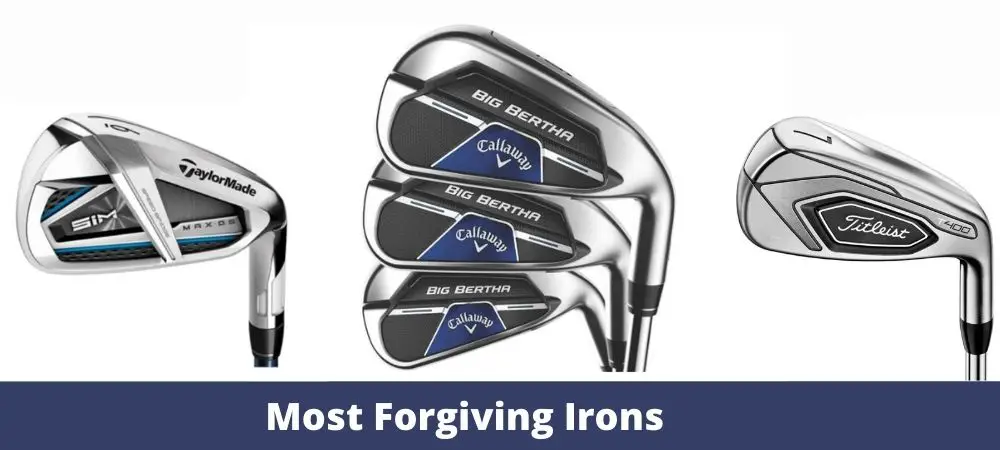This article will see what makes the most forgiving irons for beginners, yet packed with the latest technology to help golfers keep the ball long and straight and deliver a golfing experience that will significantly improve the game of entry-level players.
The most forgiving irons at a glance:
- An oversized face provides a more prominent sweet spot for greater forgiveness and higher launch
- Increased spin in the high irons for exceptional distance within 150 yards
- Speed Bridge Bar stiffens the head for more power directly to the golf ball
- Works hard to reduce side spin to minimize the impact of an unlucky hit, such as a slice.
Now let's jump straight to golf iron recommendations.

Which iron model is right for me?
Which golf irons are best for you depends on the individual strengths and weaknesses of your golf game, the type of feel, the sound on impact, and how you like the look of the irons. Irons are the clubs you use most on the golf course, so it's essential to have the right set for your game. All models promise more length and more forgiveness.
When buying the most forgiving golf irons for medium handicappers, what should I look for?
Let’s look at the features that will give the beginner to intermediate golfer a boost in speed and shot performance.
Clubhead size and design
Forged irons
The term "forged" refers to how the metal stock is formed into the clubhead: a single piece of metal is heated into a rough shape and then hammered or "forged" into the desired club head. Forged iron is usually better for low-handicappers who value shot shaping and trajectory control.
Cast irons
With "cast" irons, the material, heated in liquid form, is poured into a mold, allowing for more complex head shapes and different materials. Far cheaper and more accessible than forging, casting a club head allows for a giant club head with a more complicated, forgiving design.
Cropped hosel
Using a club with an offset hosel is all about correcting a slice. By limiting the ability to leave an open face at impact, the offset hosel gives the club head a little more time to bring the face back to square the golf ball. It may not seem like a huge advantage, but most slices golfers hit are created because the club takes a fraction of a second longer to return to the right angle.
Golf iron shaft
For mid-handicappers, there is an advantage to playing graphite shafts. Players with higher averages tend to have slower swing speeds. The math is simple, slower ball speed off the tee means longer second shots onto the green.
Graphite shafts help mid-level players because they are lighter than steel shafts. Lighter clubs mean faster swing speeds. This is why you will always see graphite shafts on woods and hybrids.
Sole design
A good rule of thumb for mid-handicappers is to find a wider club sole than your largest finger. Larger soles on golf clubs increase forgiveness but sacrifice control. However, this is a worthwhile sacrifice for golfers who need more time to work on their swing.
Clubs with wider soles are considered game-improving irons. The best golf irons for the middle are made explicitly by the equipment manufacturers to help higher handicap players get maximum height on their shots and increase ball speed.
Tungsten infused
Tungsten Infused weighting places weight in the iron sole to lower the club's center of gravity. The racquet can generate a higher launch for better carry and more distance by lowering the center of gravity. The weighting also reduces vibration and improves the feel for a more comfortable overall experience.
Extra sweet spot
An extra-wide sweet spot provides better contact quality, forgiveness, and distance, helping medium handicappers improve overall performance. The sweet spot on the iron's face is an area where the golfer gets the best performance on every shot. Hits that go off-center of the sweet spot will be shorter and less accurate.
Set composition
Mid handicap players should consider how the set's composition will affect their overall score. Since golfers can only carry 14 clubs during a round, each must help improve their game. By assembling a group that maximizes distance and improves control, the golfer covers every situation they may encounter on the course.
Front edge
The leading edge of iron is the point on the club where it first hits the ground. Shots, where the golfer strikes the ball leading edge first, are thin, low, and weak. Instead, golfers want the best center golf irons with a leading edge that moves slightly into the ground to allow the ball to hit the sweet spot.
Iron weighting
The iron has several areas where weighting is essential for a medium handicapper. Weighting at the rim of the iron head helps balance the club and improves forgiveness. Weighting in the iron sole provides launch, carry and distance with improved turf interaction.
What makes an iron set forgiving for medium handicappers?
Medium handicappers need a shaft for their irons that matches their swing speed. Because most mid-handicappers have moderate swing speeds, they use regular flex shafts. Proper shaft flex allows the golfer to bring the iron back to the correct angle at impact for a precise shot.
For a mid-handicapper, the shape of an iron head should be moderately sized. Rather than an oversized face like a Super Game Improvement iron, a mid-handicapper iron should have a medium-sized shape to deliver more distance with the ability to hit side-to-side.
Final thoughts
Next to the driver, new irons are probably the second most exciting piece of golf equipment for your golf game.
Most of the time, it's a nice shot with an iron that gets us hooked early in our golf career. So it is evident that you would soon want to own a decent set of irons.
The new iron models let you hit further and straighter than ever before. Each of our iron recommendations takes you to a new level in terms of distance, forgiveness, and feel.

Mike Regan

Mike is a weekend golfer from Connecticut and a devoted fan of the game who turned his passion into the writing experience. Any day he keeps it under 80 is a cool day. When he's not writing about golf his is playing it.

